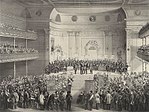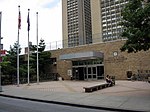The Wall (SoHo)
1973 sculpturesAluminum sculptures in New York CityMinimalismOutdoor sculptures in ManhattanSoHo, Manhattan ... and 1 more
Steel sculptures in New York City

The Wall, also known as The Gateway to Soho, is a piece of minimalist art that was constructed in the SoHo neighborhood of Manhattan, New York City. It was part of the building that stands at 599 Broadway until 2002 when the New York City Landmarks Preservation Commission (LPC) gave the owners permission to take it down so the interior wall could be repaired. The artwork has since been re-installed.
Excerpt from the Wikipedia article The Wall (SoHo) (License: CC BY-SA 3.0, Authors, Images).The Wall (SoHo)
West Houston Street, New York Manhattan
Geographical coordinates (GPS) Address Nearby Places Show on map
Geographical coordinates (GPS)
| Latitude | Longitude |
|---|---|
| N 40.725387 ° | E -73.997053 ° |
Address
Halaal cart
West Houston Street
10014 New York, Manhattan
New York, United States
Open on Google Maps








